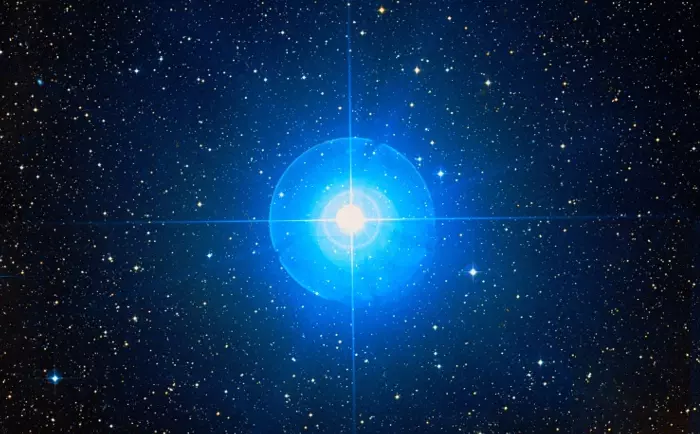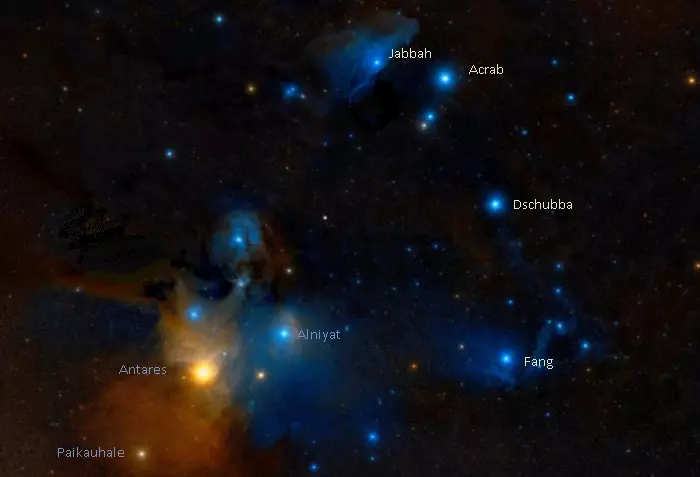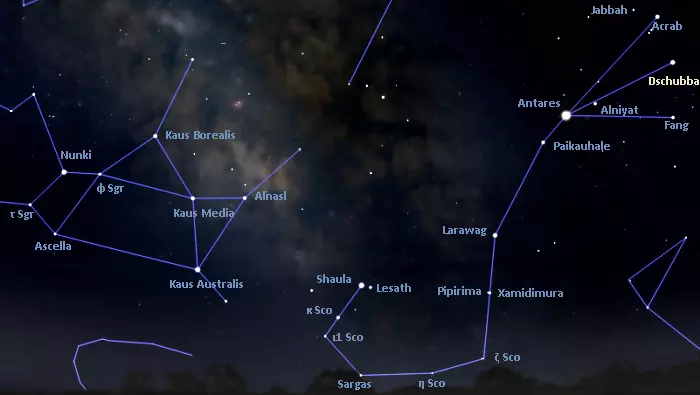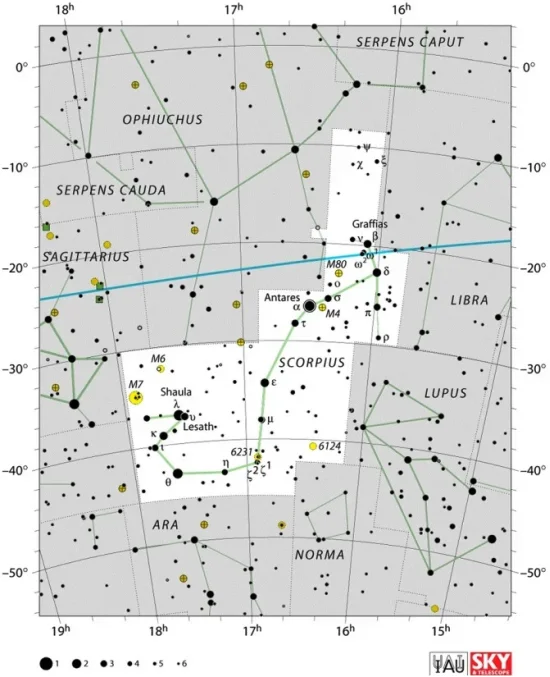Dschubba, Delta Scorpii A (δ Sco A) is the primary component in a binary system located approximately 444 light-years away in the constellation Scorpius. With an apparent magnitude that varies between 1.59 – 2.32, Dschubba is usually the fourth brightest star in Scorpius, after Antares, Shaula, and Sargas. It is one of the bright stars that outline the claws of the celestial Scorpion.
Star system
The Delta Scorpii system is a spectroscopic binary star composed of a blue subgiant of the spectral type B0.3 IV and a main sequence star with the stellar classification B1-3 V. The components are separated by only 0.2 arcseconds in the sky and shine at magnitudes 2.4 and 4.6. They have an orbital period of 10.8092 ± 0.0005 years and a semi-major axis of 0.09874 ± 0.00007 arcseconds, corresponding to a physical separation of 13.5 astronomical units.
The primary component, Delta Scorpii A, is an evolved star with a mass 13 times that of the Sun and a radius of 6.7 solar radii. With a surface temperature of 27,400 K, it is 38,000 times more luminous than the Sun. The star is a fast spinner, with a projected rotational velocity of 180 km/s. The star’s rapid rotation has produced a disk of material that now orbits the star.

Dschubba (Delta Scorpii), image: Wikisky
The companion, Delta Scorpii B, has a mass of 8.2 solar masses and an effective temperature between 20,000 and 24,000 K. It has an estimated age of 9-10 million years.
Delta Scorpii A is formally known as Dschubba. The star is classified as a Gamma Cassiopeiae variable. Gamma Cassiopeiae stars vary in brightness because they have equatorial decretion disks that occasionally reform or disappear. Most of these stars are rapidly rotating Be stars with detached shells of gas.
The brightness of Dschubba has been observed to vary from magnitude 2.32 to 1.59. At its brightest in 2003 and 2004, Delta Scorpii was the second brightest star in Scorpius, slightly brighter than Shaula. It is catalogued as AAVSO 1554-22 by the American Association of Variable Star Observers.
Dschubba would appear twice as bright without the interstellar dust that lies in the same line of sight.
Facts
Dschubba forms the Scorpion’s claws with Acrab (Beta Scorpii), Fang (Pi Scorpii), and the fainter Jabbah (Nu Scorpii). The three other stars are multiple star systems.
The claws once extended into the neighbouring constellation Libra, which was known as the Scorpion’s Claws in ancient Babylon and Greece. The traditional names of the constellation’s brightest stars – Zubeneschamali (Beta Librae) and Zubenelgenubi (Alpha2 Librae) – still reflect this. They mean “the northern claw” and “the southern claw” respectively, while the fainter Gamma Librae is known as Zubenelhakrabi, meaning “the claws of the Scorpion.”

Scorpion’s Claws, image: Wikisky
Dschubba appears 2 degrees south of the ecliptic (the Sun’s apparent path across the sky) and can be occulted by the Moon and (rarely) planets.
In 1981, NASA’s space probe Voyager 2 observed an occultation of Delta Scorpii by Saturn’s rings. Surprisingly, even the seemingly empty gaps in the rings blocked the star’s light, suggesting that there was very little empty space in Saturn’s main ring system.
Delta Scorpii is a member of Scorpius-Centaurus OB association, the nearest OB association to the solar system. It belongs to the Upper Scorpius subgroup, which also includes Antares, the brightest star in Scorpius. The members of the Upper Scorpius subgroup lie at an average distance of 470 light-years and have a mean age of 11 million years.
A study published in 2013 suggested that the Delta Scorpii system may be a runaway triple system, with a third component external to the main binary and moving in an elliptical orbit. This was based on observations of the system’s periastron passage in 2011 and the presence of a bow shock-like structure around the system.
Delta Scorpii was once a spectroscopic standard for the spectral type B0 IV. The star’s spectrum was used to classify other stars, but the system is now classified as variable and no longer used as a spectral standard.
Name
The name Dschubba (pronunciation: /ˈdʒʌbə/) was likely derived from the Arabic Al Jabhah, meaning “the forehead” and referring to the forehead of the Scorpion. Dschubba is the middle star in what was historically known as the Crown of the Scorpion, also formed by Acrab and Fang. The name was sometimes also spelled Dzuba and Al Jabba. It shares the same etymology as Jabbah, the name of Nu Scorpii. The names also have a very similar pronunciation even though they are spelled differently.
Delta Scorpii was also historically known as Iclarkrav. The name appeared in the Palermo catalogue. It is derived from the Arabic Iklil al Akrab, meaning “the crown of the scorpion.” The name Iklil (“the crown”) now formally applies to the fainter Rho Scorpii, which lies just south of Acrab, Dschubba and Fang.
The International Astronomical Union’s (IAU) Working Group on Star Names (WGSN) approved the name Dschubba for the component Delta Scorpii A on August 21, 2016. Even though the name formally applies only to the brighter component, it has traditionally been used for the whole star system.
In Chinese astronomy, Dschubba was known as 房宿三 (Fáng Xiù sān), the Third Star of Room. Room was an asterism formed by Dschubba with Acrab (Beta1 Scorpii), Beta2 Scorpii, Fang (Pi Scorpii), and Iklil (Rho Scorpii). The asterism was part of the larger Room mansion, one of the eastern mansions of the Azure Dragon. The Room mansion represented the Dragon’s abdomen.
Location
Dschubba appears south of the celestial equator, but it is easily visible from the mid-northern latitudes during the northern hemisphere summer. The star is easy to find because it is part of a prominent star pattern that represents the Scorpion’s claws. It is the middle of the three brighter stars that form the claws.
The Scorpion’s claws appear northwest of the Fish Hook, another prominent asterism in Scorpius, and the Teapot, a pattern formed by the brightest stars the constellation Sagittarius. Antares, the brightest star in Scorpius, connects the Fish Hook and the claws. The two asterisms form the constellation figure of the Scorpion.

The location of Dschubba (Dellta Scorpii), image: Stellarium
Constellation
Dschubba is located in the southern constellation Scorpius. The zodiacal Scorpion is one of the 48 Greek constellations, listed by the Greek astronomer Ptolemy in his Almagest in the 2nd century CE. In Greek lore, the constellation is associated with the scorpion that stung Orion, the Hunter. Stretching across 497 square degrees of the southern sky, it is the 33rd constellation in size out of 88.
Scorpius is one of the easiest constellations to identify. Its main constellation figure really looks like the animal it represents, with clearly outlined claws, tail, and stinger.
With 13 stars brighter than magnitude 3.0, Scorpius is one of the brighter southern constellations. The red supergiant Antares, the constellation’s luminary, is the 15th brightest star in the night sky. It marks the Scorpion’s heart. Shaula, the second brightest star, is the 24th brightest star in the sky. It marks the Scorpion’s stinger with the fainter Lesath. Antares, Shaula, and several other bright stars in Scorpius form the Fish Hook, a prominent asterism that outlines the Scorpion’s body and tail.

Scorpius constellation map by IAU and Sky&Telescope magazine
Scorpius hosts numerous multiple star systems, including Beta Scorpii (Acrab), Sigma Scorpii (Alniyat), Pi Scorpii (Fang), and Lambda Scorpii (Shaula). Bright binary systems in the constellation include Sargas (Theta Scorpii) and Paikauhale (Tau Scorpii).
The constellation contains many bright deep sky objects, among them the open clusters Messier 6 (the Butterfly Cluster), Messier 7 (the Ptolemy Cluster), NGC 6231 (the Northern Jewel Box) and NGC 6821, the planetary nebula NGC 6302 (the Butterfly Nebula), the star-forming nebulae NGC 6357 (the War and Peace Nebula or Lobster Nebula) and NGC 6334 (the Cat’s Paw Nebula), the reflection nebula IC 4592 (the Blue Horsehead), and the globular clusters Messier 4, Messier 80, and NGC 6144.
The best time of the year to see the stars and deep sky objects in Scorpius is during the month of July, when the constellation is higher above the horizon in the evening. The entire constellation is visible from locations south of the latitude 50° N, but it never rises high for observers in the mid-northern latitudes.
The 10 brightest stars in Scorpius are Antares (Alpha Sco A, mag. 0.6 – 1.6), Shaula (Lambda Sco A, mag. 1.62), Sargas (Theta Sco A, mag. 1.84), Dschubba (Delta Sco, mag 2.307), Larawag (Epsilon Sco, mag. 2.31), Kappa Sco (mag. 2.39), Acrab (Beta Sco, mag. 2.62), Lesath (Upsilon Sco, mag. 2.70), Paikauhale (Tau Sco, mag. 2.82), and Fang (Pi Sco, mag. 2.89).
Dschubba – Delta Scorpii
| Spectral class | B0.3 IV + B1-3V |
| Variable type | Gamma Cassiopeiae |
| U-B colour index | −0.920 |
| B-V colour index | −0.124 |
| Apparent magnitude | 1.59 – 2.32 |
| Absolute magnitude | −3.8 |
| Distance | 444 light-years (136 parsecs) |
| Parallax | 6.64 ± 0.89 mas |
| Radial velocity | -6.00 ± 0.5 km/s |
| Proper motion | RA: −10.21 ± 1.01 mas/yr |
| Dec.: −35.41 ± 0.71 mas/yr | |
| Mass (δ Sco A, δ Sco B) | 13 M☉, 8.2 M☉ |
| Luminosity (δ Sco A) | 38,000 L☉ |
| Radius (δ Sco A) | 6.7 R☉ |
| Temperature (δ Sco A, δ Sco B) | 27,400 K, 20,000-24,000 K |
| Age (δ Sco B) | 9-10 million years |
| Rotational velocity (δ Sco A) | 180 km/s |
| Surface gravity (δ Sco A) | 3.92 cgs |
| Constellation | Scorpius |
| Right ascension | 16h 00m 20.00528s |
| Declination | −22° 37′ 18.1431″ |
| Names and designations | Dschubba, Delta Scorpii, δ Sco, 7 Scorpii, Dzuba, Al Jabba, Iclarkrau, HD 143275, HR 5953, HIP 78401, SAO 184014, FK5 594, BD−22°4068, GC 21489, GCRV 9202, USco 45, PPM 264979, AAVSO 1554-22, ALS 14815, JP11 2695, IRAS 15573-2228, 2MASS J16002000-2237180, UBV 13563, TYC 6779-2194-1, CCDM 16003-2237, WDS J16003-2237AB |